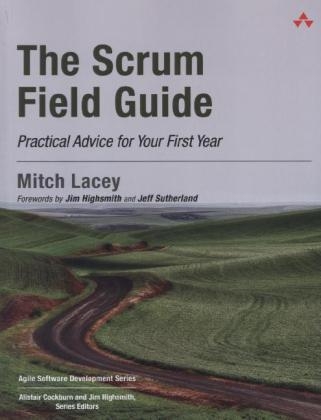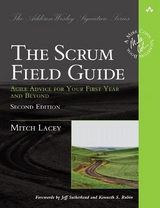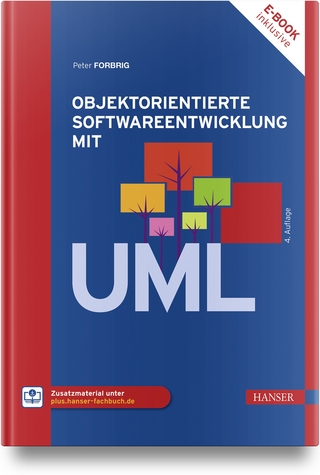
The Scrum Field Guide
Addison-Wesley Educational Publishers Inc (Verlag)
978-0-321-55415-4 (ISBN)
- Titel erscheint in neuer Auflage
- Artikel merken
In 30 brief, engaging chapters, Lacey guides you through everything from defining roles to setting priorities to determining team velocity, choosing a sprint length, and conducting customer reviews. Along the way, he explains why Scrum can seem counterintuitive, offers a solid grounding in the core agile concepts that make it work, and shows where it can (and shouldn’t) be modified. Coverage includes
Getting teams on board, and bringing new team members aboard after you’ve started
Creating a “definition of done” for the team and organization
Implementing the strong technical practices that are indispensable for agile success
Balancing predictability and adaptability in release planning
Keeping defects in check
Running productive daily standup meetings
Keeping people engaged with pair programming
Managing culture clashes on Scrum teams
Performing “emergency procedures” to get sprints back on track
Establishing a pace your team can truly sustain
Accurately costing projects, and measuring the value they deliver
Documenting Scrum projects effectively
Prioritizing and estimating large backlogs
Integrating outsourced and offshored components
Packed with real-world examples from Lacey’s own experience, this book is invaluable to everyone transitioning to agile: developers, architects, testers, managers, and project owners alike.
Mitch Lacey has been an agile practitioner and consultant and is the founder of Mitch Lacey & Associates, Inc., a software consulting and training firm. Mitch helps teams and companies realize gains in efficiency by adopting agile principles and practices such as Scrum and Extreme Programming. Mitch cut his agile teeth at Microsoft Corporation working on a variety of projects, sometimes as the product owner, other times as the ScrumMaster. Today, with more than 16 years of experience under his belt, Mitch works as an agile trainer and coach. He also continues to develop his craft by experimenting and practicing with project teams at many different organizations.Mitch is a Certified Scrum Trainer (CST) and a PMI Project Management Professional (PMP). He is a frequent speaker at conferences worldwide; has served on the board of the Scrum Alliance and the Agile Alliance; and chaired the Agile 2012 conference.
Foreword by Jim Highsmith xix Foreword by Jeff Sutherland xxi
Preface xxv
Acknowledgments xxix
About the Author xxxi
Chapter 1: Scrum: Simple, Not Easy 1
The Story 1
Scrum 6
Keys to Success 17
References 18
Part I: Getting Prepared 19
Chapter 2: Getting People On Board 21
The Story 21
The Model 27
Change Takes Time 28
Keys to Success 31
References 32
Chapter 3: Using Team Consultants to Optimize Team Performance 33
The Story 33
The Model 37
Keys to Success 45
References 48
Works Consulted 48
Chapter 4: Determining Team Velocity 49
The Story 49
The Model 54
Keys to Success 63
References 65
Chapter 5: Implementing the Scrum Roles 67
The Story 67
The Model 70
Keys to Success 76
Chapter 6: Determining Sprint Length 77
The Story 77
The Model 80
Keys to Success 87
References 88
Chapter 7: How Do We Know When We Are Done? 89
The Story 89
The Model 91
Keys to Success 97
References 97
Chapter 8: The Case for a Full-Time ScrumMaster 99
The Story 99
The Model 102
Keys to Success 108
References 112
Work Consulted 112
Part II: Field Basics 113
Chapter 9: Why Engineering Practices Are Important in Scrum 115
The Story 115
The Practices 119
Keys to Success 126
References 129
Works Consulted 129
Chapter 10: Core Hours 131
The Story 131
The Model 134
Keys to Success 138
Chapter 11: Release Planning 139
The Story 139
The Model 142
Keys to Success 151
References 152
Chapter 12: Decomposing Stories and Tasks 153
The Story 153
The Model 155
Keys to Success 163
References 164
Works Consulted 164
Chapter 13: Keeping Defects in Check 165
The Story 165
The Model 166
Keys to Success 169
References 169
Work Consulted 170
Chapter 14: Sustained Engineering and Scrum 171
The Story 171
The Model 174
Keys to Success 177
References 178
Chapter 15: The Sprint Review 179
The Story 179
The Model 182
Keys to Success 185
Works Consulted 187
Chapter 16: Retrospectives 189
The Story 189
The Practice 191
Keys to Success 196
References 197
Part III: First Aid 199
Chapter 17: Running a Productive Daily Standup Meeting 201
The Story 201
The Model 204
Keys to Success 2 09
Chapter 18: The Fourth Question in Scrum 213
The Story 213
The Model 216
Keys to Success 216
References 217
Chapter 19: Keeping People Engaged with Pair Programming 219
The Story 219
The Model 221
Keys to Success 226
References 227
Chapter 20: Adding New Team Members 229
The Story 229
The Model 231
Keys to Success 234
References 235
Chapter 21: When Cultures Collide 237
The Story 237
The Model 242
Keys to Success 247
References 250
Works Consulted 250
Chapter 22: Sprint Emergency Procedures 251
The Story 251
The Model 253
Keys to Success 256
References 257
Part IV: Advanced Survival Techniques 259
Chapter 23: Sustainable Pace 261
The Story 261
The Model 265
Keys to Success 270
References 271
Chapter 24: Delivering Working Software 273
The Story 273
The Model 277
Keys to Success 280
Work Consulted 283
Chapter 25: Optimizing and Measuring Value 285
The Story 285
The Model 287
Keys to Success 292
Works Consulted 293
Chapter 26: Up-Front Project Costing 295
The Story 295
The Model 299
Keys to Success 303
References 304
Chapter 27: Documentation in Scrum Projects 305
The Story 305
The Model 308
Keys to Success 315
References 316
Chapter 28: Outsourcing and Offshoring 317
The Story 317
The Model 320
Keys to Success 324
References 329
Work Consulted 329
Chapter 29: Prioritizing and Estimating Large Backlogs 331
The Story 331
The Model 334
Keys to Success 338
References 340
Chapter 30: Writing Contracts 341
The Story 341
The Model 345
Keys to Success 353
References 356
Appendix: Scrum Framework 357
The Roles 357
The Artifacts 359
The Meetings 361
Putting It All Together 364
Index 365
| Erscheint lt. Verlag | 29.3.2012 |
|---|---|
| Verlagsort | New Jersey |
| Sprache | englisch |
| Maße | 179 x 231 mm |
| Gewicht | 660 g |
| Themenwelt | Informatik ► Software Entwicklung ► Agile Software Entwicklung |
| ISBN-10 | 0-321-55415-9 / 0321554159 |
| ISBN-13 | 978-0-321-55415-4 / 9780321554154 |
| Zustand | Neuware |
| Informationen gemäß Produktsicherheitsverordnung (GPSR) | |
| Haben Sie eine Frage zum Produkt? |
aus dem Bereich



